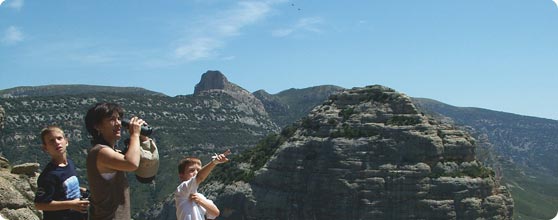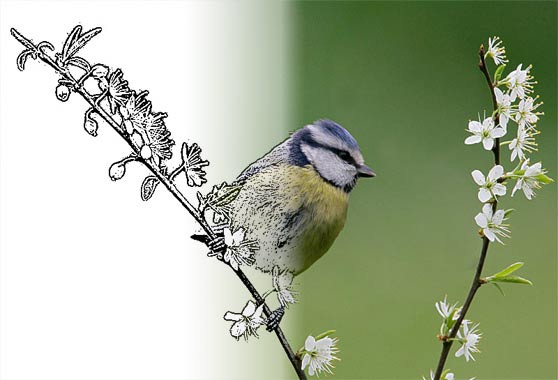More Birdy Stuff
Iinteresting and complementary information about birding in spain. Learn about our recommended NHH (Natual Hotspot Holidays) or why bringing your family with you if you're planning a birding trip to spain, some kid's stuff to introduce them to birding or some tasty free birding downloads like free chapters of the books written by Steve West.
Natural Hotspot Holidays
Expect the unexpected
Birdinginspain.com is not satisfied with being "just another bird tour company". Our ambition is to set standards that others will eventually follow. Even though Steve West has been living and birding in northeast Spain for 20 years, has written two books based on the birds of the region and contributed to others, that is not enough.
BirdingInSpain.com is and wants to be committed to conservation, and declares so unashamedly. And with conservation in mind we have developed the concept of "Natural Hotspot Holidays".

The basic idea of a Natural Hotspot Holiday is to identify natural hotspots – small areas with an incredibly high biodiversity and an unusual array of landscapes. Within a 25 kilometre (16 mile) radius of an imaginary centre of a natural hotspot it will be possible to see more than 120 species of birds, and some very special birds at that.
These are some of the benefits of doing a Natural Hotspot Holiday:
- Much less driving (lower carbon emissions), a more relaxing peace and more time to enjoy wildlife
- Detailed knowledge of the most interesting places for the birder and naturalist
- Wide range of scarce or emblematic species like Lammergeier, Bonelli's Eagle, Little Bustard, Roller, etc.
- Accommodation at small rural hotels as close as possible to the best birding areas.
- Nature aside, we are also well set to enable you to enjoy the best of the rest – gastronomy, festivals...
- Visiting the area without destroying any part of the natural wealth that you have come here to see.
- Participating in a hotspot holiday will help to raise local awareness of the benefits of sustainable tourism.
- Bring your family too, if they don't want to take part in the Hotspot Holiday, you can request our programme leave them with us.
- Depending on the group preferences, we can arrange a visit to a local point of cultural or historical interest.
- Joining a Natural Hotspot Holiday will help to protect the local environment and benefit local populations.
Are you interested? Follow these links to get detailed info
- What is a Natural Hotspot Holiday?
- What can i do on a Natural Hotspot Holiday?
- Benefits of joining a Natural Hotspot Holiday trip (in-depth)
- Pricing and customer's quotes
Special programs
Birding with your Family
Because many birders form part of a family, and they don't want to be left at home
There's no reason why you shouldn't bring your family too. If they don't share your interest in birds and don't want to participate in a birding tour then they can be directed to interesting sites of tourism interest nearby, or could even be persuaded to take part in some novel and exciting activities. In other words birding or…ballooning, rafting, cycling, wining and dining, etc.
Port Aventura, Costa Brava and Costa Daurada, trekking, rafting, cycling and horse-riding in the Pyrenees, Boí Valley world Heritage churches, Gaudí's Sagrada Familia, canoes and pleasure boats, museums, castles, cathedrals, towns and villages stepped in history, water sports, skiing, world famous olive oil and wine, sunshine, amazing scenery, boutiques, friendly family accommodation...
"Hey kids, want to go to Port Aventura in Spain this summer?" (Birding thought: Red-necked nightjars breed in the grounds).
"We could go ballooning over Montsec." (Birding thought: Lammergeiers are regularly seen in that part of northeast Spain).
"We can do a bit of trekking in the Pyrenees in the morning and then rafting in the afternoon to cool off." (Birding thought: And I could spot Citril Finch and Black Woodpecker in the Pyrenees).
"The views from Mont-roig are breathtaking!" (Birding thought: And according to Where the birds are in northeast Spain Mont-roig is a reliable site for Black Wheatear and Blue Rock Thrush).
"Darling, in the Ebro valley area wines of international renown are produced, like Somontano or Raïmat." (Birding thought: With a bit of luck we could get lost and bump into a Little Bustard or two).

And then you can always round off the day with a paella, or fresh fish washed down with an excellent wine....and make your birding…er….holiday plans for the next day. Those are just a few examples of what you can do. For more detailed information about the activities that can be done check the must visit section of the birding itinerary you're going to do.
If what you're looking for is a reason to leave your family behind, sorry but you won't find it here!
Kid's Stuff
Learn Birdy things while having fun
How to obtain Footprint Moulds:
Bird Quiz: (in PDF)
Madelyn has found this useful resource she wants to share
A Guide to Finding Local Birds

Free Birding downloads - Something for nothing. While it lasts
However if you order a book, enquire about my guiding services, or use the links then I'll be encouraged to keep the downloads coming. If not...
Featured Downloads (in PDF):
Steve West's First Book Free Chapters
Steve West's Second Book Free Chapters
Videos
Viaje ornitológico a Turquia / Birding trip in Turquey (SPA)
Viaje Ornitológico a Turquia 2011 con BirdingInSpain, del 27 de mayo al 5 de junio 2011.
Video con una pequeña muestra de algunas de las aves que esperamos ver en este viaje ornitológico de 10 días por el sur de Turquía. El Perdigallo del Caspio, el Trepador de Krüper, el Martín Pescador de Esmirno … ¡y muchas más!
Para más información Contacta con Steve West.
Checklists (in PDF):
Spot the intentional mistake and win a free copy of Steve West's "Where the birds are in northeast Spain"!
In one of the checklists there is an intentional spelling mistake (there is probably more than one mistake but only one of them is intentional!). If you are one of the first 3 to spot and communicate it you will win a free copy of the afore-mentioned book, P&P apart.
As a clue, it is in the English names section, and is a bird that has an extra letter added to its name to make another word that can be found in the average English dictionary.
Need another clue? No, that would spoil the surprise.
 Show InfoCanary Islands Species Checklist
Show InfoCanary Islands Species Checklist -
 Show InfoFin Norway Species Checklist
Show InfoFin Norway Species Checklist -
 Show InfoNortheast Spain Species Checklist
Show InfoNortheast Spain Species Checklist -
 Show InfoScotland Species Checklist
Show InfoScotland Species Checklist -
 Show InfoS. Morocco Species Checklist
Show InfoS. Morocco Species Checklist -
 Show InfoNorth Norfolk Species Checklist
Show InfoNorth Norfolk Species Checklist  Show InfoBulgaria Species Checklist
Show InfoBulgaria Species Checklist  Show InfoExtremadura Species Checklist
Show InfoExtremadura Species Checklist
Canary Islands Checklist
One good thing about birding in the Canary Islands is that you can go at virtually any time of the year and still find most of the birds that you want to see. By combining just two islands, Tenerife and Fuerteventura, it is possible to see all the endemic species of this archipelago. You may, however, like to visit la Palma, Lanzarote or la Gomera, which are not without interest to the visiting birdwatcher.
Species to try for are Blue Chaffinch, Fuerteventura Stonechat, Canary Islands Goldcrest, Bolle's Pigeon, Laurel Pigeon (all endemics), Berthelot's Pipit, Plain Swift, Canary, Houbara Bustard, Cream-coloured Courser, Barbary Partridge, Trumpeter Finch, Black-bellied Sandgrouse, Barbary Falcon, Ruddy Shelduck and Cory's Shearwater.
There is also much potential interest with seabirds, with Bulwer's Shearwater, Little Shearwater, Madeiran Storm Petrel, White-faced Petrel and Red-billed Tropicbird all possibilities, although good planning and some luck will be required to see any of them.
Finland and Northern Norway Checklist
A checklist for a late spring/early summer visit to Finland and northern Norway. A trip that every European birder should do at least once.
The potential rewards of birding in Finland speak for themselves: Hawk Owl, Tengmalm's Owl, Pygmy Owl, Eagle Owl, Great Grey owl, Ural Owl, Three-toed Woodpecker, Hazel Grouse, Siberian Jay, Pine Grosbeak, Red-flanked Bluetail, Siberian Tit, Smew, Red-necked Grebe, Little Bunting, Rustic Bunting, Terek Sandpiper....However, be warned. Birding in this land of the midnight sun is far from easy and birds can be very few and far between. So either get a guide or prepare to work very hard – remember though, the birds are worth it!
Northern Norway is another thing altogether. If the sun shines you can be bathed in birding glory. The tundra springs to life with its surprising array of breeding birds: Ptarmigan, Willow Grouse, Arctic and Long-tailed Skuas, Red-throated Pipit, Snow Bunting, Lapland Bunting, Shore Lark, Dotterel, Temminck's Stint, Long-tailed Duck, Red-necked Phalarope, Ruff, Bean Goose, etc.
Then you visit the shoreline, and discover the meaning of abundance. White-tailed Eagle, Puffin, Brunnich's Guillemot, Common and Velvet Scoter, Goosander, Eider, King Eider, Steller's Eider, Glaucous Gull, Rough-legged Buzzard, Gyrfalcon, Purple Sandpiper, Arctic Redpoll, divers. And in such numbers that will not allow you to forget your trip to Norway!
Birding Finland and Northern Norway: what a contrast!
Northeast Spain Checklist
This is the home ground of Birding in Spain, and an excellent proposal at any time of the year, although April and May are the most popular months with visiting tours. Combine a Mediterranean wetland with lowlands, gallery woodland, steppes, Pre-Pyrenees and Pyrenees to get as much as you can out of this exciting area.
Some of the birding highlights include:
Wetland birds in the Ebro Delta or the Aigumolls de l'Empord - Audouin's and Slender-billed Gulls, Purple Gallinule, Whiskered Tern, Gull-billed Tern, Caspian Tern, Collared Pratincole, Squacco Heron, Glossy Ibis, Purple Heron, Little Bittern, Great White Heron, Cattle Egret, Greater Flamingo, Red Crested Pochard, Black-necked Grebe, Savi's Warbler, Penduline Tit, Moustached Warbler, etc.
Waders including Temminck's Stint and Marsh Sandpiper, and the rarer but fairly regular Red-necked Phalarope.
Seabirds including Balearic, Levantine and Cory's Shearwaters, Mediterranean Gull and more.
Steppeland birds in the Ebro valley - such as Black-bellied and Pin-tailed Sandgrouse, Little Bustard, Dupont's, Calandra, Short-toed, Lesser Short-toed and Thekla Larks, Spectacled Warbler, Roller, and Great Spotted Cuckoo.
Raptors including Lammergeier, Lesser Kestrel, Bonelli's Eagle, Booted Eagle, Egyptian Vulture, Montagu's Harrier and migrating Red-footed Falcons.
Other assorted highlights like Rock Thrush, Black Wheatear, Ortolan Bunting, Black Woodpecker, and last but by no means least, the stunning Wallcreeper.
Scotland Checklist
An early summer trip to the highlands of Scotland, including one or more of the western islands – perhaps Handa, or one of the inner or outer Hebrides. Combine the rugged solitude of the west coast, with its innumerable lochs and lochans, thriving seabird colonies, white sand beaches, cliffs and imposing mountain peaks, with the more bucolic east coast, with its distilleries, castles, rivers, glens, Caledonian forest and moors – oh! How could I forget to mention the Cairngorms? That spectacular mountain plateau with 4 of the 5 highest peaks in the British Isles and some very special breeding birds.
Some of the trips specialities include: Snow Bunting, Ptarmigan, Dotterel, Ring Ouzel, Golden Eagle, Slavonian Grebe, Red Grouse, Short-eared Owl, Capercaillie, Black Grouse, Parrot Crossbill, Scottish Crossbill, Crested Tit, Osprey, Common and Velvet Scoter (in the east).
West coast highlights could be: marvellous seabird colonies at Handa (an experience in itself that should not be missed), with its Puffins, Guillemots, Razorbills, Kittiwakes, Fulmars, Shags, Great and Arctic Skuas, Arctic Terns, Red-throated Divers, Black Guillemots and much more. Corncrake, White-tailed Eagle, Black-throated Diver, Great Northern Diver, Golden Plover, Greenshank, Storm Petrel, Manx Shearwater, Twite, Dipper, Goosander, etc.
And then there's the scenery!
Southern Morocco Birder's Checklist
This is essentially a checklist for a birder visiting Morocco to the south of Marrakech between the desert town of Erfoud and the coastal resort of Agadir. As such the list includes bird species that can be seen in the High Atlas, in the wetlands and from the headlands along the coast near Agadir, in the desert areas in the extreme south-east of the area, including the famous Erg Chebbi, and at all sites in-between.
Anyone used to birding within the confines of Europe after their first birdwatching trip to Morocco will be left with the indelible impression that Morocco is "another world". The people and their way of life, the climate, the variety of incredible landscapes and some unique birds; all of these factors work together to constantly remind the visitor that he or she has stepped onto another continent.
Birds of prey are scarce in Morocco compared to in Spain, large numbers of them having fallen victim to widespread and intensive poisoning campaigns. Nevertheless, there are still around 30 very special species of birds in southern Morocco that can't be seen in the Iberian Peninsula or almost anywhere else in Europe.
One could start with the larks for example: where else can the birder see both Temminck's and Horned Lark in the same country? Along with the prized Thick-billed Lark, the spectacular Hoopoe Lark, Desert Lark, Bar-tailed Lark, Lesser Short-toed and Short-toed Lark, Crested and Thekla Lark. Something similar also happens with the wheatears, with Mourning, White-tailed (a common roadside bird in many places!), Red-rumped, Black, Desert, Black-eared, Northern and even Isabelline Wheatears all possible.
Then there are also 4 species of sandgrouse, Lanner and Barbary Falcon, Desert Sparrow, the highly endangered Bald Ibis, Black-crowned Tchagra, Little Swift, and a long and interesting etcetera.
If you can afford 10 days or so to cast your birder's eye on this area then you won't regret it. Oh, another thing: birding Morocco is a lot cheaper than birding Norway!
North Norfolk Winter Checklist
This is a birding checklist for a short winter break in north Norfolk. North Norfolk is a great place for a birding trip at almost any time of the year, with its large number of Nature Reserves from Snettisham, Holme, Titchwell, Cley etc., along the length of the coast, as well as the famous Norfolk Broads.
Regular winter specialities in this region include Snow Bunting, Shore Lark, Twite, Purple Sandpiper, Rough-legged Buzzard, Waxwing, Glaucous Gull, Velvet Scoter, Long-tailed Duck, Whooper and Bewick's Swan, and of course large numbers and variety of waders, ducks and geese. The more regular of the latter include thousands of Pink-footed and Brent Goose, and smaller numbers of Greylag, White-fronted, Egyptian, Bean and every now and then a beautiful Red-breasted Goose, just to liven things up a little!
Sea-watching is a worthwhile pastime with Red-necked and Slavonian Grebes, Red-throated and Black-throated Divers all likely, while pleasant surprises may include Great Northern Diver or Little Auk.
But the only real way of knowing what is about is to get out there and look for the birds yourself!
Bulgaria checklist description
This is a birding checklist for a spring/summer trip to Bulgaria; a country that is fast emerging, if not already established, as one of the top destinations for birding in Europe.
Not only does Bulgaria occupy a strategic place on the Via Pontica flyway, ideal for observing the migration of soaring birds, it is also home to important wintering areas for geese, especially the Red-breasted Goose. Many birders however, time their visit for spring, perhaps because it's when Bulgaria and its birds are at their very best.
The highlights of a birding trip to Bulgaria are many. The surprising mountains along Bulgaria's southern border boast one of the best sites in Europe for the dazzling Wallcreeper, in addition to interesting species like Horned Lark, Nutcracker, Grey-headed, Three-toed and Black Woodpeckers, and the elusive Hazel Grouse. In the southeast corner of the country the threatened Eastern Imperial Eagle still manages to hold its own, along with Masked Shrike, Levant Sparrowhawk, Olive Tree Warbler, Barred Warbler and Western Rock Nuthatch. Sites of renown along the inviting Black Sea coast include Atanasovsko, Lake Dourankoulak and Cape Kaliakra, where birding delights include the likes of Paddyfield Warbler, White Pelican, Dalmatian Pelican, Pygmy Cormorant, Pied Wheatear and a host of migrants if your timing is right. Special mention should go to the biosphere reserve of Lake Srebarna on the right bank of the River Danube, truly impressive for its abundance and array of wetland birds.
Thankfully it's a relatively small country and so the visiting birder can plan to see a large part of the wonderful birds that Bulgaria has to offer on a single trip. Although, as always, it's better not to rush.
Extremadura checklist description
Extremadura is one of the most popular birding regions in Spain, and such popularity is extremely well justified. Personally I can't remember having seen 5 species of eagle in one morning anywhere at all except in Extremadura.
That happened on one glorious April morning in Monfragüe, now a National Park. But that is far from being the end of the story: in addition to Spanish Imperial Eagle, Golden Eagle, Bonelli's Eagle, Booted Eagle and Short-toed Eagle in Monfragüe it is possible to see 3 species of vulture (Black, Griffon and Egyptian), the magnificent Eagle Owl, Black Stork, Azure-winged Magpie, Red-rumped Swallow, Spanish Sparrow, Blue Rock Thrush, Alpine Swift, and more.
Then there's the dehesa, home of the free range pata negra pig and the cork oak. A unique and beautiful setting in which to look for birds like the Azure-winged Magpie, Black-winged Kite, Rock Sparrow, Orphean Warbler, Hawfinch, etc.
The steppes around Cáceres and, further south, la Serena are home to another range of special birds and as such add a great deal of quality to a birding trip to Extremadura. Here one can find Great Spotted Cuckoo, Great Bustard, Little Bustard, Montagu's Harrier, Collared Pratincole, Calandra Lark, Short-toed Lark, Roller and Stone Curlew.
There are a few interesting wetland sites too, where the visiting birder can seek out more variety in the form of Purple Gallinule, Savi's Warbler, Gull-billed Tern, Penduline Tit, Spoonbill, egrets and herons. And then there are one or two historic town centres ideal for sitting at a terrace bar, sipping an ice coffee while sorting out the Pallid Swifts from the Common Swifts and admiring groups of Lesser Kestrels and clusters of White Storks' nests.




